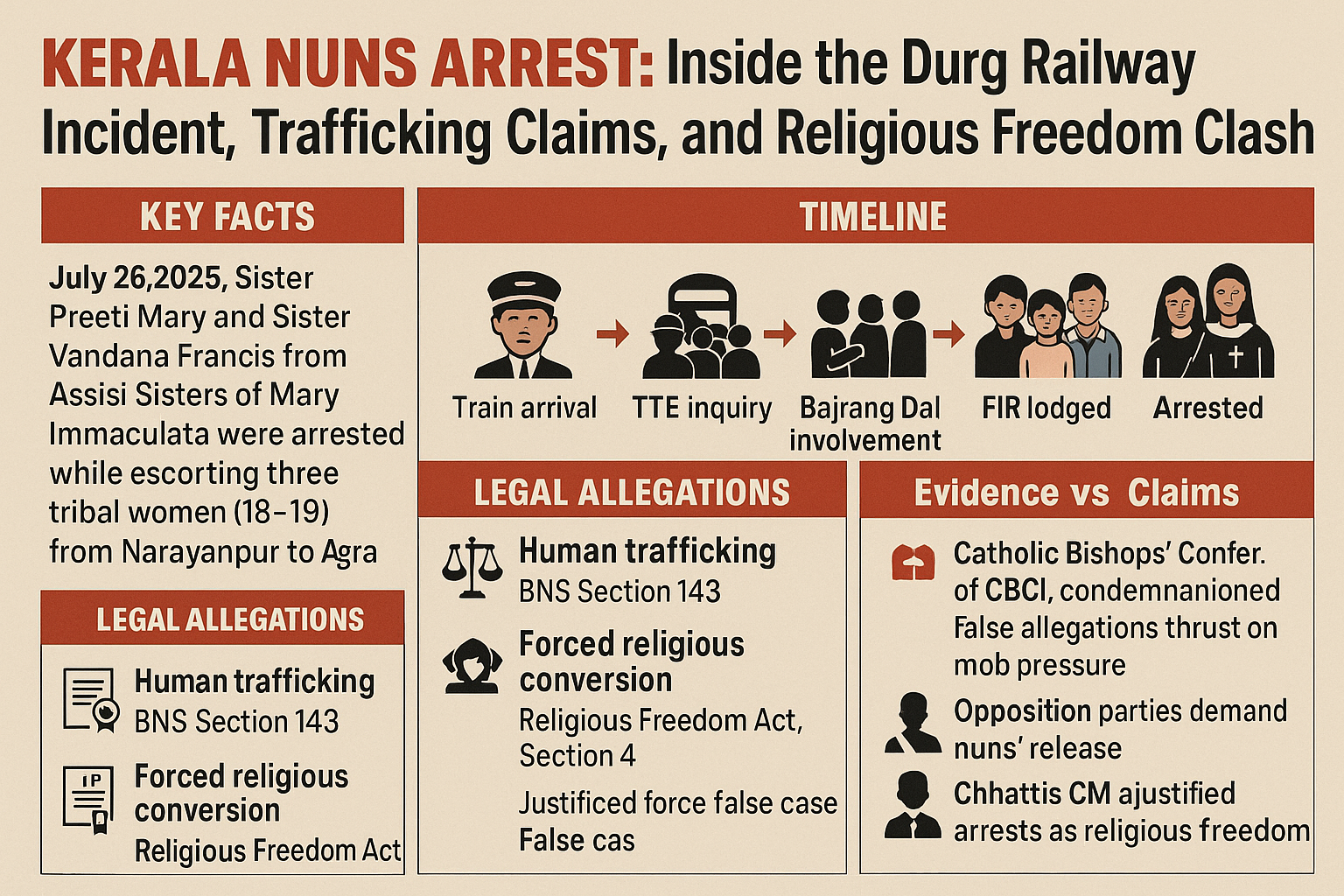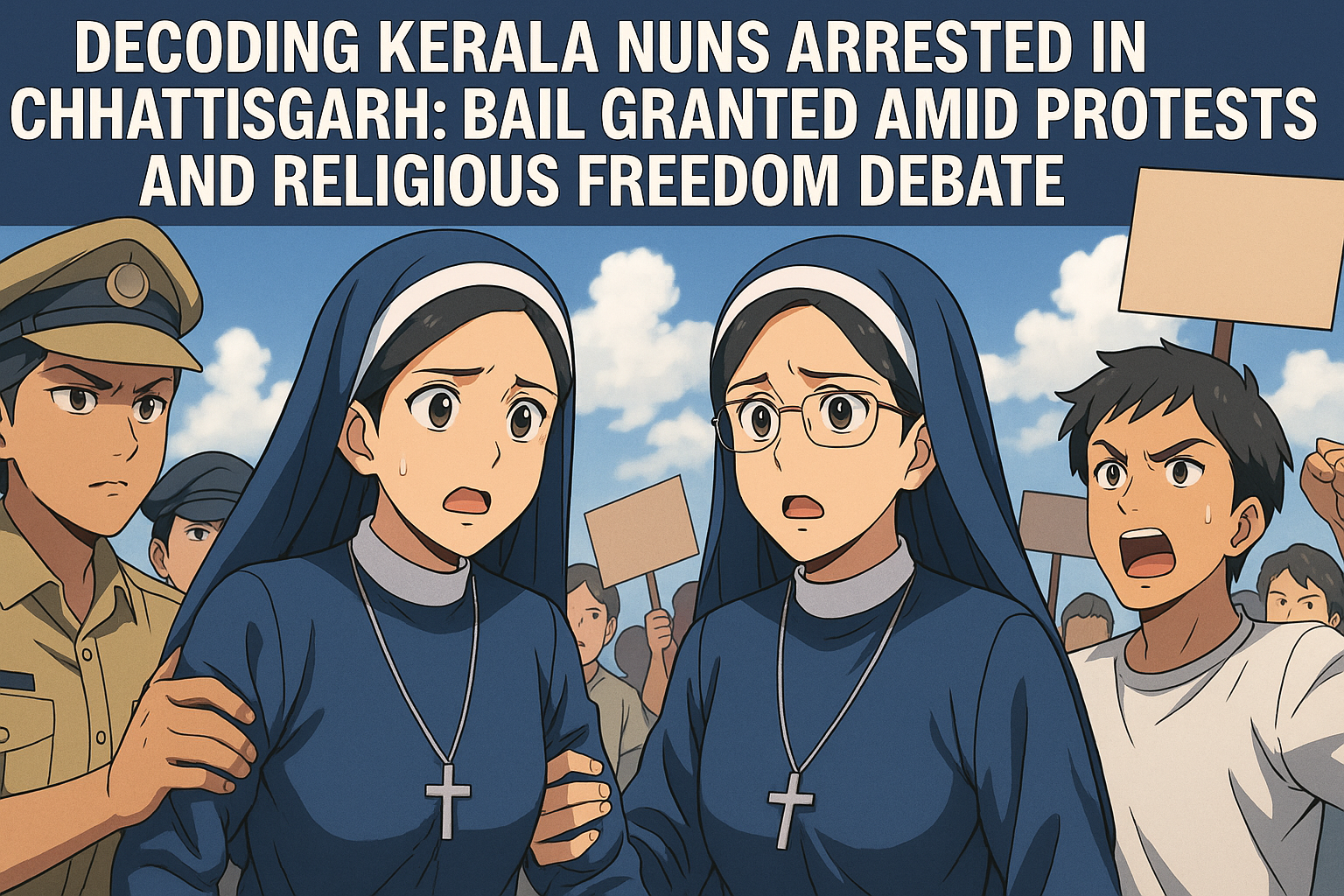Two Kerala-based Catholic nuns and a tribal youth were arrested at Chhattisgarh's Durg station on suspicion of trafficking and conversion.
1. WHO: The People at the Center
Arrested Individuals:
- Sister Preeti Mary (45) and Sister Vandana Francis (50), both of the Assisi Sisters of Mary Immaculate, based in Kerala.
- Sukhman Mandavi (19), a tribal youth from Narayanpur, Chhattisgarh.
The Young Women:
- Three tribal girls aged 18–19, all from Maoist-affected Narayanpur district, headed to Agra for convent work as kitchen assistants.
- Each had written parental consent and identification documents.
Complainant:
- Jyoti Sharma, a local Bajrang Dal activist, initiated the complaint after being alerted by a railway ticket examiner (TTE).
Church and Political Voices:
- Kerala Chief Minister Pinarayi Vijayan, Congress leaders like K.C. Venugopal, and several church authorities have condemned the arrest.
- The Catholic Bishops’ Conference of India (CBCI), Kerala Council of Churches, and other denominations have rallied for the release of the detainees.
2. WHAT: The Allegations and Charges
Legal Charges:
- Section 143(3) of the Bharatiya Nyaya Sanhita (BNS) for alleged human trafficking.
- Section 4 of the Chhattisgarh Religious Freedom Act (1968) for alleged religious conversion through coercion.
Church’s Stand:
- The girls were adults, not coerced, and had legal documentation.
- This was a job placement—not trafficking or conversion.
Police Version:
- Authorities cite procedural gaps: lack of “palayan register” entries and suspicion of intent to convert tribal youth.
3. WHEN: Detailed Timeline
- Pre-July 25, 2025: Preparations to move three women from Narayanpur to Agra with consented plans.
- July 25–26: Group intercepted at Durg Station. TTE contacts Bajrang Dal; police arrest follows mob protest.
- July 27–28: Political protests erupt in Kerala and Delhi. UDF and church groups demand intervention.
- July 29: Custody extended until August 8. The three women moved to a state-run shelter; nuns and youth remain detained.
4. WHERE: Geographic & Contextual Scope
- Narayanpur: Home district of the girls—tribal, Maoist-affected, and socioeconomically vulnerable.
- Durg Railway Station: Point of interception. Mob-led pressure led to police action.
- Agra: Final destination for convent work with religious institutions.
5. WHY: Underlying Motives and Conflicts
Religious and Social Tensions:
- Tribal women moving to Christian institutions triggered suspicions of religious conversion.
- Bajrang Dal’s involvement fits a broader pattern of anti-Christian mobilization under the guise of anti-trafficking vigilance.
Political Climate:
- Tensions heightened by BJP’s state leadership in Chhattisgarh and national anti-conversion rhetoric.
Legal Overreach or Prejudice?
- Critics argue the police acted under mob pressure rather than evidence.
- No action was taken against Bajrang Dal for intimidation.
6. HOW: The Arrest Unfolded and Next Steps
Process Failures:
- Police acted based on allegations without verifying documents.
- The women’s statements may have been obtained under coercion.
Legal Path Ahead:
- Bail hearings are expected before August 8.
- The opposition and civil rights groups demand judicial review and withdrawal of FIR.
Calls for Reform:
- Church leaders and legal experts demand that anti-conversion laws be reevaluated to prevent misuse.
- Civil society advocates request legal protections for religious workers and tribal youth seeking employment.
Detailed Timeline of the Incident
Journey and Arrest:
- The group boarded a train from Narayanpur to Durg with plans to reach Agra.
- Upon reaching Durg, a TTE questioned the group and alerted Bajrang Dal.
- Within minutes, a mob assembled and protested on the platform.
- The police detained the nuns and youth under political and public pressure.
Document Analysis:
- All three girls carried consent letters and IDs.
- Police claimed absence of official village-level travel entries, which became the basis for FIRs.
Reaction:
- Kerala CM Pinarayi Vijayan, CPI(M) MP John Brittas, and Congress leaders called it a “blatant misuse of law.”
- CBCI and other church authorities denounced it as “mob justice.”
Legal and Policy Context
Chhattisgarh’s Religious Freedom Act (1968):
- Penalizes conversion by inducement, force, or fraud—frequently used to target tribal-Christian activities.
Rising Trend of Religious Intimidation:
- United Christian Forum reports 834 incidents against Christians in 2024, up from 127 in 2014.
Civil Rights Concerns:
- The case exemplifies growing overlap between vigilante action and law enforcement.
- Raises critical questions about police neutrality in communally sensitive cases.
What’s at Stake
- Will the courts dismiss the charges for lack of evidence?
- Will Bajrang Dal face scrutiny for vigilante involvement?
- Can religious institutions safely provide employment to tribal youth in the current political climate?
Conclusion
The Durg railway arrest is not an isolated law enforcement case—it is a window into the state of religious freedom, minority rights, and the fragile balance between law and vigilantism in India. As judicial proceedings advance, the nation must decide whether it upholds due process or continues down a path where perception overrides legality.



